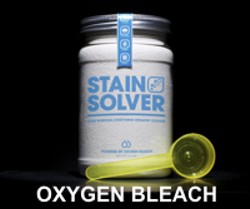Painting Exterior Stucco
DEAR TIM: My house was built in 1985, and I have never painted the stucco. I plan to do it this year. I've noticed other houses in the same neighborhood that have a black bleed coming through the stucco and have no idea what is causing this to happen. Should I use a special type of paint or somehow prepare the surface? It always looks more obvious after it has rained. Doug Prehm, Dublin, OH
DEAR DOUG: I realize you want to paint your stucco, but I'm going to do my best to talk you out of this. Since the stucco has never been painted, you're transforming a maintenance-free surface to one that's going to require periodic work. I caution you to think about this long and hard, especially when I give you a few other options that may allow you to achieve your goal.

This stucco wall has to be cleaned and sealed before the final paint is applied. Photo Credit: Doug Prehm
First, I'll assume you just want the stucco to look better since you have the issue with the black stains. The photo you sent me provides an excellent clue as to one possible source of your problem, although I can't speak about the other houses that have similar stains.
You've got bushes and a tree that are growing close to the stucco wall. The deciduous tree could be fueling mold and mildew growth from aerosol sugars that are possibly being emitted from the leaves. The shade created by the tree is a perfect breeding ground for mold growth as it creates a tiny microclimate near the stucco that raises the humidity level. Mold and mildew need water to flourish.
The other clue you provided could be very significant. You said that the stucco has never been painted. This means the calcium carbonate that's undoubtedly in the stucco mixture could be fueling the growth of an algae that's plagued asphalt shingle roofs for decades. If your stucco had been painted years ago, the calcium carbonate would be covered and not readily available to the algae.
Gloeocapsa magma is a very hardy algae that feeds on calcium carbonate. The black stains you see could possibly be an accumulation of their dead, dark-colored cells. This particular algae can grow anywhere, but it really loves humid conditions. Not only does it get humid in central Ohio, but the vegetation near this wall is also adding to the humid conditions.
The good news is that it's easy to remove the black stains no matter if they're mold, mildew or the algae. I would highly recommend that you use an oxygen bleach solution to clean the black stains. Do NOT use chlorine bleach, or sodium hypochlorite, as this will kill the bushes and trees next to your home. Chlorine bleach is highly toxic to just about any vegetation.
opens in a new window opens in a new windowOxygen bleach is a powder you mix with water. Once dissolved you simply put it in a hand-pump garden sprayer and saturate the stucco. Try to work on an overcast day. Keep the stucco very wet with the solution for up to 30 minutes. Use a stiff scrub brush dipped in the solution to remove the black stains. You can add some regular liquid dish soap to enhance the cleaning. Rinse immediately with clear water from a garden hose.
opens in a new windowOxygen bleach is a powder you mix with water. Once dissolved you simply put it in a hand-pump garden sprayer and saturate the stucco. Try to work on an overcast day. Keep the stucco very wet with the solution for up to 30 minutes. Use a stiff scrub brush dipped in the solution to remove the black stains. You can add some regular liquid dish soap to enhance the cleaning. Rinse immediately with clear water from a garden hose.
To keep the stucco free of mold, mildew and algae, you can simply periodically clean it with just liquid dish soap and water. If the stains are caused by mold and mildew, this washing removes the invisible food they're feasting on. If the stains are the black algae, then you have to introduce copper to keep the stucco looking superb.
Copper is a natural biocide that will stop the growth of mold, mildew and the algae. The trouble is you have to come up with a way to attach small copper strips to the upper parts of the walls so that each time it rains, a minuscule amount of copper washes down the wall. This will keep the stucco looking fantastic.
Installing copper strips on asphalt shingle roofs is easy as you just put the strips of copper up under the last row of shingles. Putting copper on vertical stucco walls is challenging both from a functional standpoint but also a decorative one.
If you decide to forgo the copper and you want a color change to the stucco, I suggest you consider staining the stucco. Yes, you can purchase masonry penetrating stains that will soak into the stucco and impart color just like when you stain wood.
The advantage of using a penetrating stain that soaks into the stucco is that over time it will not peel. If you paint your stucco, at some point the paint WILL peel. No matter if you use the stain or paint, you absolutely must get rid of the black stains before applying either product. You don't want to trap mold, mildew or algae behind either stain or paint.
Realize that some paints and stains contain food for mildew and algae! Oil-based coatings often contain natural oils that mold and mildew find quite tasty. Manufacturers commonly put mildewcides and other chemicals in the oil-based paints to slow the organic growth. Avoid these issues by using an acrylic or urethane coating or one made with synthetic resins.
Column 995